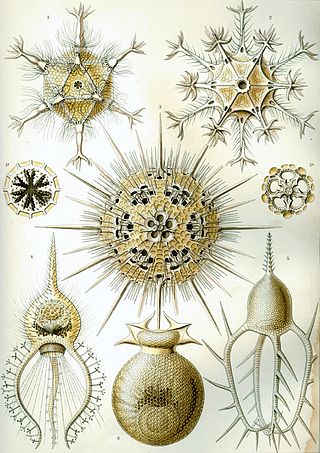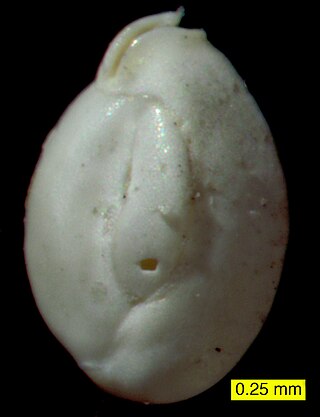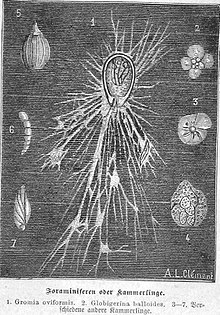
Xenophyophorea is a clade of foraminiferans. Xenophyophores are multinucleate unicellular organisms found on the ocean floor throughout the world's oceans, at depths of 500 to 10,600 metres. They are a kind of foraminiferan that extract minerals from their surroundings and use them to form an exoskeleton known as a test.

Foraminifera are single-celled organisms, members of a phylum or class of Rhizarian protists characterized by streaming granular ectoplasm for catching food and other uses; and commonly an external shell of diverse forms and materials. Tests of chitin are believed to be the most primitive type. Most foraminifera are marine, the majority of which live on or within the seafloor sediment, while a smaller number float in the water column at various depths, which belong to the suborder Globigerinina. Fewer are known from freshwater or brackish conditions, and some very few (nonaquatic) soil species have been identified through molecular analysis of small subunit ribosomal DNA.

Cercozoa is a phylum of diverse single-celled eukaryotes. They lack shared morphological characteristics at the microscopic level, and are instead united by molecular phylogenies of rRNA and actin or polyubiquitin. They were the first major eukaryotic group to be recognized mainly through molecular phylogenies. They are the natural predators of many species of bacteria. They are closely related to the phylum Retaria, comprising amoeboids that usually have complex shells, and together form a supergroup called Rhizaria.

The Rhizaria are a diverse and species-rich supergroup of mostly unicellular eukaryotes. Except for the Chlorarachniophytes and three species in the genus Paulinella in the phylum Cercozoa, they are all non-photosynthethic, but many foraminifera and radiolaria have a symbiotic relationship with unicellular algae. A multicellular form, Guttulinopsis vulgaris, a cellular slime mold, has been described. This group was used by Cavalier-Smith in 2002, although the term "Rhizaria" had been long used for clades within the currently recognized taxon. Being described mainly from rDNA sequences, they vary considerably in form, having no clear morphological distinctive characters (synapomorphies), but for the most part they are amoeboids with filose, reticulose, or microtubule-supported pseudopods. In the absence of an apomorphy, the group is ill-defined, and its composition has been very fluid. Some Rhizaria possess mineral exoskeletons, which are in different clades within Rhizaria made out of opal, celestite, or calcite. Certain species can attain sizes of more than a centimeter with some species being able to form cylindrical colonies approximately 1 cm in diameter and greater than 1 m in length. They feed by capturing and engulfing prey with the extensions of their pseudopodia; forms that are symbiotic with unicellular algae contribute significantly to the total primary production of the ocean.

Phaeodarea or Phaeodaria is a group of amoeboid cercozoan organisms. They are traditionally considered radiolarians, but in molecular trees do not appear to be close relatives of the other groups, and are instead placed among the Cercozoa. They are distinguished by the structure of their central capsule and by the presence of a phaeodium, an aggregate of waste particles within the cell.

Lobosa is a taxonomic group of amoebae in the phylum Amoebozoa. Most lobosans possess broad, bluntly rounded pseudopods, although one genus in the group, the recently discovered Sapocribrum, has slender and threadlike (filose) pseudopodia. In current classification schemes, Lobosa is a subphylum, composed mainly of amoebae that have lobose pseudopods but lack cilia or flagella.

The Allogromiida is an order of single-chambered, mostly organic-walled foraminiferans, including some that produce agglutinated tests (Lagynacea). Genetic studies indicate that some foraminiferans with agglutinated tests, previously included in the Textulariida or as their own order Astrorhizida, may also belong here. Allogromiids produce relatively simple tests, usually with a single chamber, similar to those of other protists such as Gromia. They are found as both marine and freshwater forms, and are the oldest forms known from the fossil record.
The Komokiacea are a small group of amoeboid protozoa, considered to be foraminifera, though there have been suggestions that they are a separate group, closely related to foraminifera. Komokiacea are rather large organisms, often exceeding 300 micrometers in maximum dimensions. Along with Xenophyophores they dominate the macro- and megabenthic fauna in the deep sea and are commonly referred to as "giants protists".

Gromia sphaerica is a large spherical testate amoeba, a single-celled eukaryotic organism and the largest of its genus, Gromia. The genus itself contains about 13 known species, 3 of which were discovered as late as 2005. It was discovered in 2000, along the Oman margin of the Arabian sea, at depths around 1,163 to 1,194 meters. Specimens range in size from 4.7 to 38 millimeters in diameter. The test is usually spherical in shape and honeycombed with pores. There are filaments on the bottom of the organism, where it is in contact with the seafloor, and it is mostly filled with stercomata.

Testate amoebae are a polyphyletic group of unicellular amoeboid protists, which differ from naked amoebae in the presence of a test that partially encloses the cell, with an aperture from which the pseudopodia emerge, that provides the amoeba with shelter from predators and environmental conditions.

Quinqueloculina is a genus of foraminifera in the family Miliolidae.
Paleodictyon nodosum is a living creature thought to produce a certain form of burrow nearly identical to Paleodictyon fossils. The modern burrows were found around mid-ocean ridge systems in the Pacific and Atlantic Oceans. Although scientists have collected many of the burrows of Paleodictyon nodosum, they have never seen a live one. What a live specimen would look like is widely debated, with the debate being split into two main sides.

Reticulomyxa is a monospecific genus of freshwater foraminiferans. The type species is the unicellular Reticulomyxa filosa. It is found in freshwater environments as well as moist environments, like decomposing matter and damp soils. The heterotrophic naked foraminiferan can feed on microbes as well has larger organisms and is able to be sustained in culture by supplemented nutrients such as wheat germ and oats. The large, multinucleate foraminferan is characteristic for its lack of test and named for the network of connecting pseudopodia surrounding its central body mass. The organism has unique bidirectional cytoplasmic streaming throughout the anastomosing pseudopodia that is some of the fastest reported organelle transport observed. Reticulomyxa was first described in 1949 and is commonly used as a model organism for the unique transport of organelles throughout the cytoplasm of pseudopodia by cytoskeletal mechanisms. Only asexual reproduction of this genus has been observed in culture, but the genome possesses genes related to meiosis suggesting it is capable of sexually reproductive life stages.

An amoeba, often called an amoeboid, is a type of cell or unicellular organism with the ability to alter its shape, primarily by extending and retracting pseudopods. Amoebae do not form a single taxonomic group; instead, they are found in every major lineage of eukaryotic organisms. Amoeboid cells occur not only among the protozoa, but also in fungi, algae, and animals.
Stercomata are extracellular pellets of waste material produced by some groups of foraminiferans, including xenophyophoreans and komokiaceans, Gromia, and testate amoebae. The pellets are ovoid (egg-shaped), brownish in color, and on average measure from 10-20 µm in length. Stercomata are composed of small mineral grains and undigested waste products held together by strands of glycosaminoglycans.

"Monothalamea" is a grouping of foraminiferans, traditionally consisting of all foraminifera with single-chambered tests. Recent work has shown that the grouping is paraphyletic, and as such does not constitute a natural group; nonetheless, the name "monothalamea" continues to be used by foraminifera workers out of convenience.

Occultammina is a genus of xenophyophorean foraminifera known from the Atlantic and Pacific oceans. It is notable for being the first known infaunal xenophyophore as well as for being a possible identity for the enigmatic trace fossil Paleodictyon.

Foraminiferal tests are the tests of Foraminifera.
Mayorella marianaensis is a species of amoebozoan protist discovered in 2023 in Mariana Trench sediments. It belongs to the order Dermamoebida, a group of naked amoebae with a thick glycocalyx.
Limnofila is a genus of heterotrophic protists that live in freshwater habitats and feed on bacteria. They are also present in the soil ecosystem, where they play an important role as predators of bacteria. They are classified as a single family Limnofilidae and order Limnofilida.













